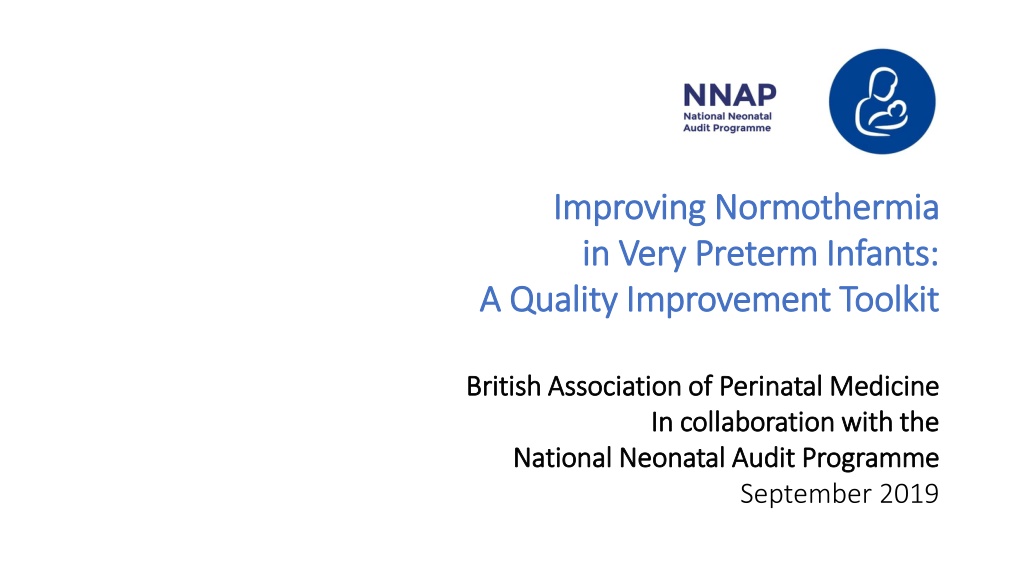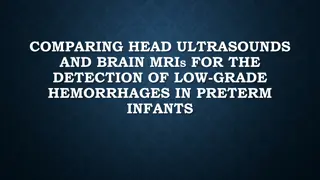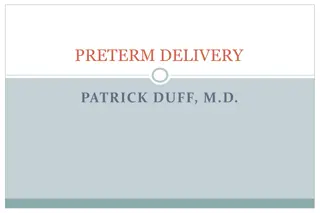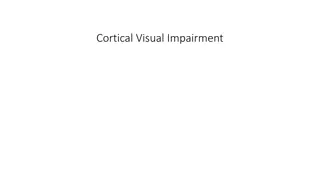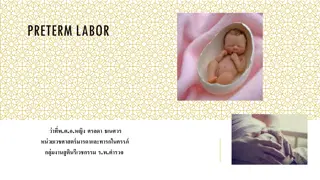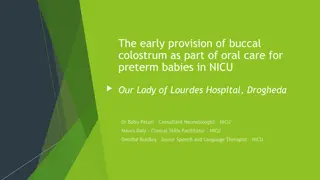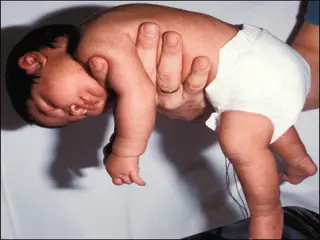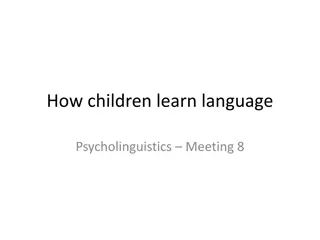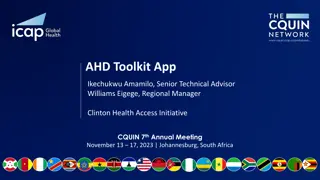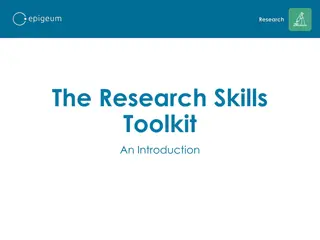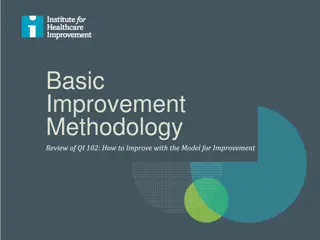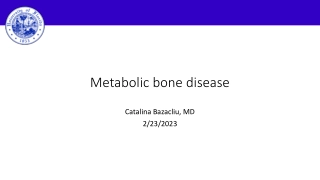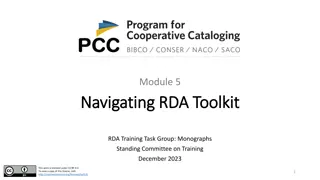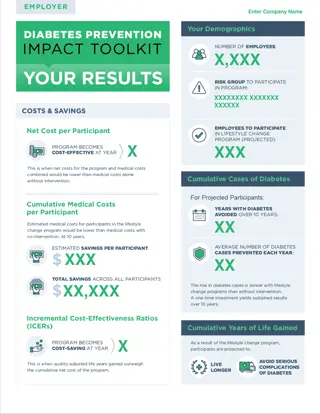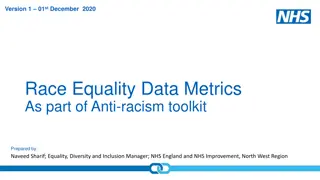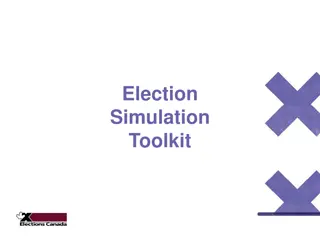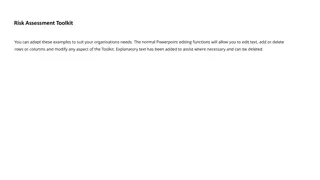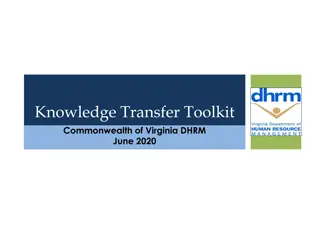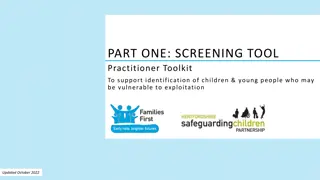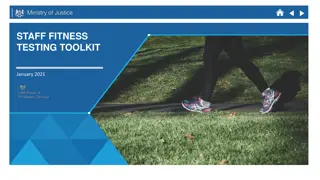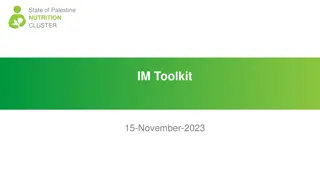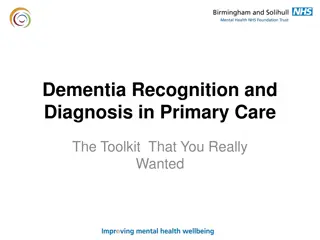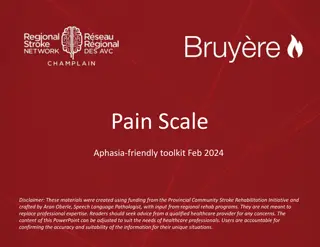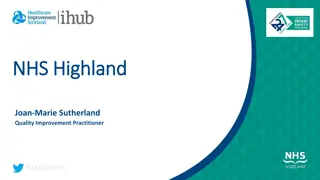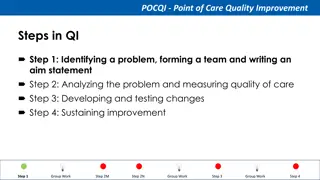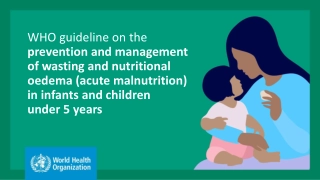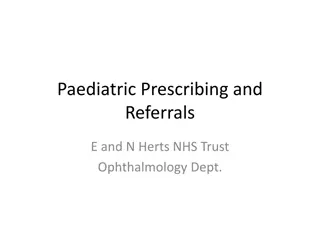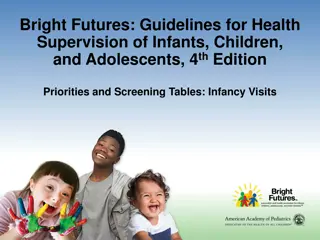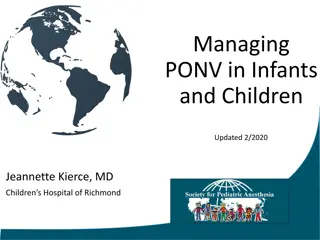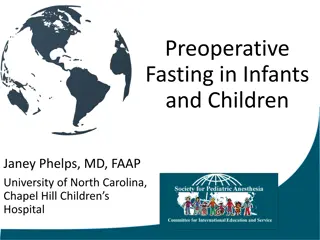Quality Improvement Toolkit for Improving Normothermia in Very Preterm Infants
This resource provides a comprehensive toolkit developed by the British Association of Perinatal Medicine in collaboration with the National Neonatal Audit Programme to assist clinicians in neonatal units in delivering normothermia to very preterm infants. It includes evidence-based interventions, data interrogation tools, quality improvement activities, and resources for monitoring and improving normothermia outcomes. The rationale highlights the risks of hypothermia in preterm babies and the associated adverse effects. The collaborative effort aims to align with global standards for newborn care and maternal-neonatal health safety.
Download Presentation

Please find below an Image/Link to download the presentation.
The content on the website is provided AS IS for your information and personal use only. It may not be sold, licensed, or shared on other websites without obtaining consent from the author. Download presentation by click this link. If you encounter any issues during the download, it is possible that the publisher has removed the file from their server.
E N D
Presentation Transcript
Related image Improving Normothermia Improving Normothermia in Very Preterm Infants: in Very Preterm Infants: A Quality Improvement Toolkit A Quality Improvement Toolkit British Association of Perinatal Medicine British Association of Perinatal Medicine In collaboration with the In collaboration with the National Neonatal Audit Programme National Neonatal Audit Programme September 2019
Purpose Purpose To facilitate delivery of normothermia by clinicians in neonatal units by providing practical quality improvement (QI) resources in the form of a toolkit and supporting materials This toolkit will: Provide the evidence base for effective interventions Facilitate units in interrogating their own data and processes in order to undertake selected quality improvement activities suited to the local context Assist units in interpreting and monitoring the results of their QI activity Provide and signpost resources to facilitate QI in the area of improving normothermia in preterm infants
Rationale Rationale Preterm babies are at increased risk of hypothermiawith associated adverse effects, including an increased risk of: hypoglycaemia hypoxia and metabolic acidosis respiratory distress chronic lung disease necrotising enterocolitis intraventricular haemorrhage late-onset sepsis death
Maternity and Children Quality Improvement Collaborative British Association of Perinatal Medicine National Neonatal Audit Programme Drivers for preterm Drivers for preterm normothermia within normothermia within PRETERM NORMOTHERMIA UK the UK the UK World Health Organisation Resuscitation Council European Standards of Care for Newborn Health Maternal Neonatal Health Safety Collaborative
Evidence and professional recommendations Evidence and professional recommendations
Mechanism of heat loss Loss of moisture and heat from warm wet skin into a low humidity, cooler environment Intervention Occlusive plastic wrap/bag Evidence or Professional Recommendation A 2018 Cochrane Review concluded that plastic wraps improved core body temperature on admission to NICU and that fewer infants had hypothermia on admission to NICU or up to 2 hours after birth with a number needed to treat for an additional beneficial outcome of 43. Evaporation Woollen or plastic hat Loss of moisture and heat from respiratory tract mucosa Warm, humidified gases Two multicentre, randomised controlled trials have shown significant reductions in admission hypothermia in preterm infants resuscitated using warm, humidified inspired gases above standard care (wrap, woollen hat and radiant heat) 20,21. The American Heart Association (AHA) 22, European Resuscitation Council (ERC) 23, UK Resuscitation Council24, World Health Organisation (WHO) 1 and International Liaison Committee for Resuscitation (ILCOR)4 all recommend increased room temperature for anticipated preterm deliveries <32 weeks. The recommended temperature varies from 23-26 C. There are multiple studies demonstrating the benefit of increased room temperature on body temperature at 5 mins from birth and admission temperature 25-30. The Cochrane review reports meta-analysis of two studies (119 infants) comparing plastic bags and thermal mattresses with plastic bags alone for infants <31 weeks gestation3. Results showed improvement in core body temperature on admission to the NICU or up to two hours after birth but with an increase in elevated temperature. NB: Manufacturer safety guidance recommends these mattresses should not be used in conjunction with other heat sources due to the rare but potentially serious risk of severe burns. Units who choose to use transwarmers should be aware of this guidance. Strict vigilance must be undertaken to ensure skin integrity, and avoidance of hyperthermia by continuous interscapular temperature monitoring and limiting duration of use particularly in the context of radiant heat. Recommended as standard care by ILCOR and UK Resuscitation council4, 24. Heat loss due to cooler circulating air, particularly in the context of open windows and doors Increased room temperature Convection Heat loss due to direct contact with cooler surfaces Transwarmer or exothermic mattress Conduction Non direct transfer of heat to cooler mediums Radiant heat source Radiation For all references see Normothermia Toolkit
Phase 4 Phase 1 Phase 2 Phase 3 Phase 5 Phase Approach Identify the problem and how large it is Methods and Tools Forcefield analysis Fishbone diagram Case review Process mapping Pareto chart Learn from experts Driver diagram Outcome 1. Define the problem Define the problem, diagnose why the problem occurs and what improvement would look like Overview of Overview of the the Improvement Improvement Journey Journey 2. Develop a shared Form a team of enthusiasts Engaging a team Engaging stakeholders Establish a shared objective and a culture for change purpose 3. Plan and Formulate, prioritise and test solutions Test, review and re-test improvements Project Charter QI Methodology Complete a formalised plan of proposed improvements implement changes 4. Test and measure improvement Measurement Run chart Statistical Process Control Chart Days between Chart Determine whether improvement has resulted in change 5. Implement, embed and sustain Implement widely and ensure sustainability Education Communication Motivation Governance Shared learning and embedding changes into practice
Understand your local data, both now and in recent past Consider data in context of national standards/benchmarking Use one or two of the following tools to understand your data: Forcefield analysis Fishbone diagram Case review Process mapping Pareto chart Develop an improvement plan using a driver diagram Learn what works by talking to high performing units Phase One: Phase One: Define the Define the Problem Problem
Phase Two: Develop a Shared Purpose Phase Two: Develop a Shared Purpose 1. Engage your team A Neonatal or Paediatric project lead (medical or nursing) Multidisciplinary representation including Neonatologists/paediatricians Neonatal nurses Midwives Obstetricians Labour Ward and Theatre representatives Aim for parent representation And ideally people with QI expertise
Phase Two: Develop a Shared Purpose Phase Two: Develop a Shared Purpose 2. Engage your stakeholders: Which other teams need to be reached to make your project successful? Senior and junior paediatricians Neonatal nurses Midwives Obstetricians Theatre staff Prioritise us Understand us Inform us
Phase Three: Plan and Implement Changes Phase Three: Plan and Implement Changes Construct a Project Charter: Detail your proposed improvement, including the resources required and the potential benefits to patients Formulate, prioritise and test solutions using established QI methodology, e.g: Model for Improvement LEAN Six Sigma Control Define Measur e Improve Analyse
Phase Four: Test and Measure Improvement Phase Four: Test and Measure Improvement 1. Collect the best data for your needs Outcome measures: reflect the impact on the patient e.g. the admission temperature Process measures: the way systems and processes work to deliver the desired outcome e.g. the proportion of times a plastic bag is applied; the environmental temperature. Process measures audit compliance with your change ideas. Balancing measures: this is what may be happening elsewhere in the system as a result of the change e.g. by avoiding hypothermia there may be an increase in elevated temperatures.
Phase Four: Test and Measure Improvement Phase Four: Test and Measure Improvement 2. Use well-described methods to analyse and display your data: Run chart Statistical Process Control Chart Days between chart Percentage of admission temperatures 36.5- 37.5C <32 weeks Days between non-normothermic admission temperatures Percentage of admission temperature 36.5-37.5C <32 weeks 100 300 100 95 250 90 90 200 80 85 70 150 80 60 100 75 50 70 50 40 65 0 Median after intervention Mean Lower confidence limit Lower warning limit
Spread: Dissemination: formal eg presentations Diffusion: informal eg word of mouth Exception reporting: Case review for noncompliant cases Barriers and loss of motivation: Understand Talk to key individuals Observe clinical practice in action Use a questionnaire to survey staff Brainstorm with a focus group Find solutions Educate, educate, educate Use opinion leaders to influence Reminder systems Prompt feedback Phase Five: Phase Five: Implement, Embed Implement, Embed and Sustain and Sustain
BAPM Quality Webpages Specific BAPM resources at https://www.bapm.org/qimadeeasy Planning your QI project Investigating your current practice Planning your change idea (amend title) Interpreting your data (amend title) QI tools and QI tools and templates templates Other QI resources at BAPM QI Signpost: https://www.bapm.org/signpost-qi-resources
SHIP (Stopping Hypothermia in Premmies) Project, Thames Valley and Wessex ODN: www.mproveacademy.com Register, then login to view toolkit. QI initiatives QI initiatives- - unit and unit and network level network level First Hour of Care: Quick Reference Manual, East of England ODN. https://www.networks.nhs.uk/nhs- networks/eoe-neonatal-odn/first-hour-of-care- 2/fhoc-quick-reference-manual-online
Core Measurement Plan, Maternity and Childrens Quality Improvement Collaborative, Scottish Patient Safety Programme https://ihub.scot/media/1404/20180508-neonatal-core- measurementplan-final.pdf Temperature Management in newborn Infants, European Standards of Care for Newborn Health 2018 https://newborn-health- standards.org/temperature-management-infants/ Postnatal support of transition and resuscitation, , European Standards of Care for Newborn Health 2018. https://newborn-health- standards.org/postnatal-support-transition-resuscitation/ Organisational Organisational standards, standards, guidelines and guidelines and initiatives initiatives NHS England NICU Quality Dashboard https://www.england.nhs.uk/wp- content/uploads/2018/03/nicu-metric-definitions-2018-19.pdf NNAP 2018 Report on 2017 Data, National Neonatal Audit Programme. https://www.rcpch.ac.uk/resources/national-neonatal-audit-programme- annual-report-2018-2017-data Maternity and Neonatal Health Safety Collaborative https://improvement.nhs.uk/documents/3595/Driver_Diagram_and_Cha nge_Package_Optimisation_of_Very_Preterm_Infant.pdf Wyllie J et al. European Resuscitation Council Guidelines for Resuscitation 2015: Section 7. Resuscitation and support of transition of babies at birth. Resuscitation 2015; 95: 249-63 https://ercguidelines.elsevierresource.com/ european-resuscitation- council-guidelines-resuscitation-2015-section-7-resuscitation-and- support/fulltext
